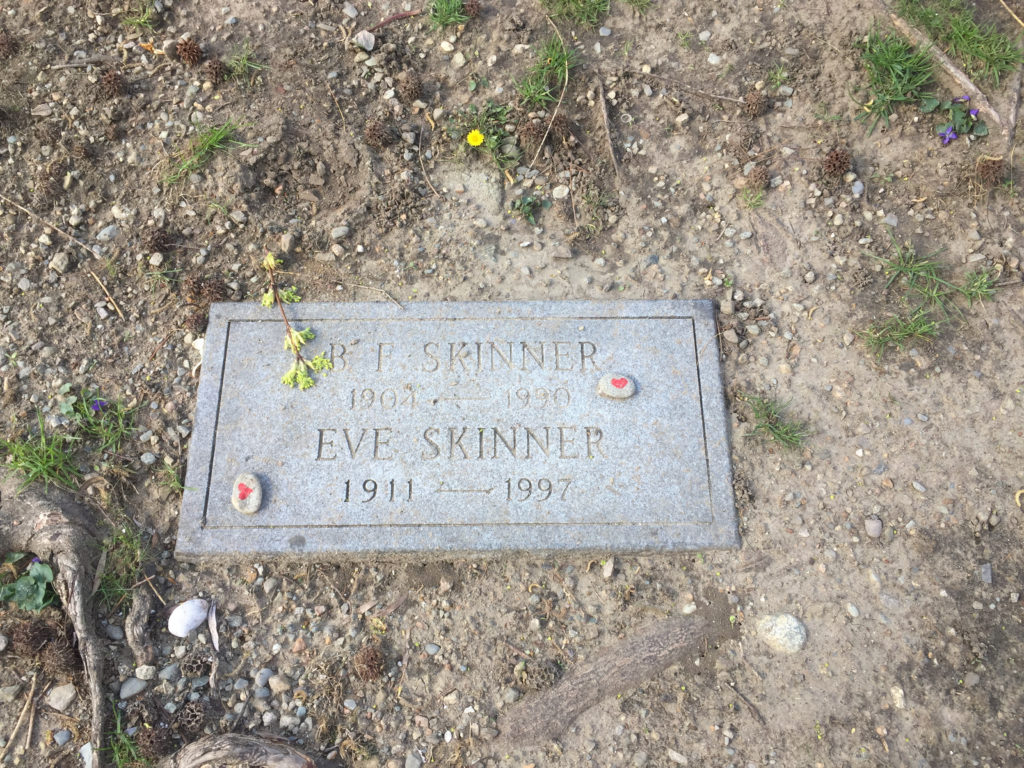Erik Visits an American Grave, Part 873
This is the grave of B.F. Skinner.

Born in Susquehanna, Pennsylvania in 1904, Skinner grew up in a deeply religious household, but rejected it by the time he was a teen and became an atheist. He was a tinkerer as a kid too who spent a lot of time messing around with machines and trying to invent stuff. He attended Hamilton College in upstate New York and wanted to be a writer. He was unpopular. That’s because he used his position at the college newspaper to write about atheism, something not exactly accepted in the conservative upstate college in the early 20s. He became sort of interested in psychology while at college, but really wanted to write. He moved home after college and spent the next few years locked in his room trying to write The Great American Novel. He actually had some encouragement here, including from Robert Frost, who somehow knew him. But Skinner realized that he hadn’t actually experienced life so how could he write The Great American Novel? He couldn’t. Desperate, lost, adrift, he decided to go into the other thing that sort of interested him: psychology. He applied to graduate school in psychology, got into Harvard, and…yeah that worked out for him.
Skinner got into behaviorism. Now, I am going to get out of my depth very, very fast when discussing psychology. In fact, of all the social sciences, this is the one about which I know the least and it’s really not even close. So I am just going to sketch this out the best I can and you all can talk about it more in comments. And if I get things wrong, sue me. Behaviorism is the belief that people’s actions are replicable, learned behaviors. This had the convenient side effect of making it testable in a lab setting. I will leave my usual snark about social scientists just wanting things they can “objectively” test instead of the messiness of the real world aside for a minute, or maybe i won’t. His 1938 book Behaviour of Organisms, set this out, focusing on how behaviors can be controlled and why stimuli produce certain actions within people. Reinforcement was central to this and key to Skinner’s research going forward after his first book. Positive and negative reinforcement affected both behavior and was shaped by natural law, said the psychologist extremely influenced by Charles Darwin. He worked on different forms of reinforcement at different time variables. So he influenced psychiatric hospitals to give patients token when they exhibited positive behavior in order to encourage more of that.
Skinner also never gave up his tinkering side and got creative with his inventions during his life. He invented an air crib that was a sort of box that babies would be stuck to limit the hell of childrearing. Later, people said it was child torture. There were even long rumors that his own daughter committed suicide after being stuck in this for her early childhood, but these are totally unfounded, even if they have a lot of legs. The Skinner Box was a tool for testing animal behavior in the lab that provided positive or negative reinforcement. We’ve all seen this sort of thing, with animals getting a treat for doing the right thing. His cumulative recorder was a pre-computing invention to record data. His “teaching machines” were also a pre-computing invention to improve classroom performance through positive stimuli. Heck, he even tried to invent a missile tracking device during World War II, though the Navy didn’t bite.
Skinner’s major impact in the world was on teaching, especially through his emphasis on rewarding behavior. He pushed for a more active teaching that got the student invested rather than being a rote recipient of boring information. In his 1968 book The Technology of Teaching, he urged teacher training on why teaching can be effective and what to do and not to do in the classroom. What to do was to break tasks down for students, make them feel this was positive, never punish through more education, etc. He developed this after seeing his daughter’s fourth grade math teacher and thinking she was terrible at her job.
Skinner published widely. I’ve never read his 1948 utopian novel Walden Two, but it sounds like a trip, a story about a soldier returned from World War II, not to the same society as before, but rather a utopian society where a planned community works by operating on Skinner’s behavioral techniques. That same year, he left Indiana University for Harvard, where he remained the rest of his career. Unlike a lot of super elite academics who can be pretty indifferent to graduate students, he mentored many top graduate students in the field. Although an academic superstar, much of his writing remained quite opaque to non-specialists, such as his 1957 book Verbal Behavior, which confused even many in his field for a long time. He took a lot of criticism too, particularly from Noam Chomsky, who basically claimed Skinner was doing fake science, laboratory work completely unrelated to real-life humans. But je kept writing, trying to make himself clear to the general public, until the day he died. In 1989, he was diagnosed with leukemia. He knew it was over. He gave a last speech to the American Psychological Association. He then wrote an article based on that speech. The day he submitted the article, in 1990, he died. He was 86 years old.
Not media shy, Skinner gave plenty of interviews you can watch.
B.F. Skinner is buried in Mount Auburn Cemetery, Cambridge, Massachusetts.
If you would like this series to butcher the work of other psychologists, you can donate to cover the required expenses here. Erik Erikson is in Harwich, Massachusetts and John B. Watson is in Westport, Connecticut. Previous posts in this series are archived here.


